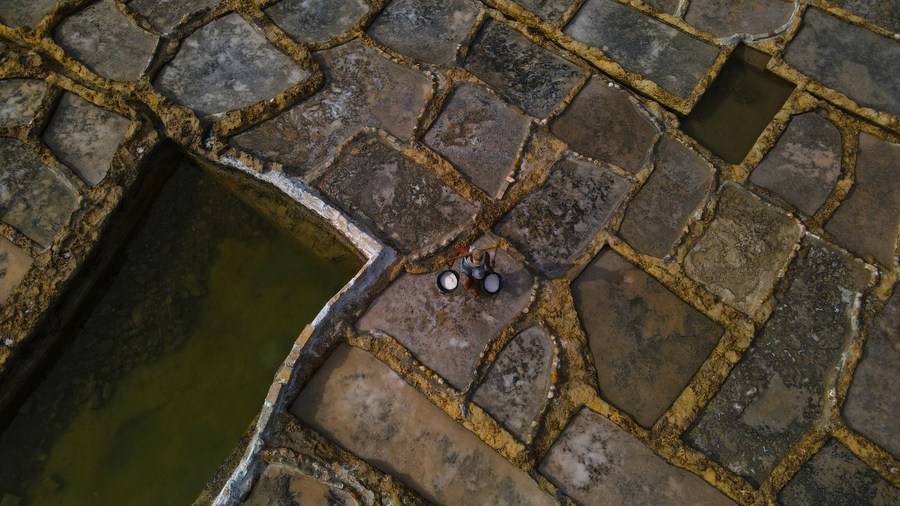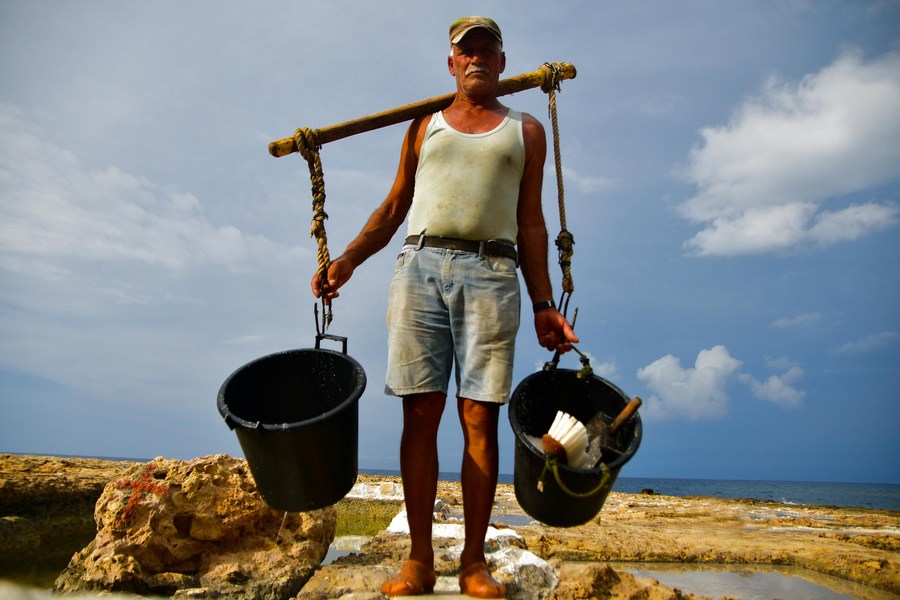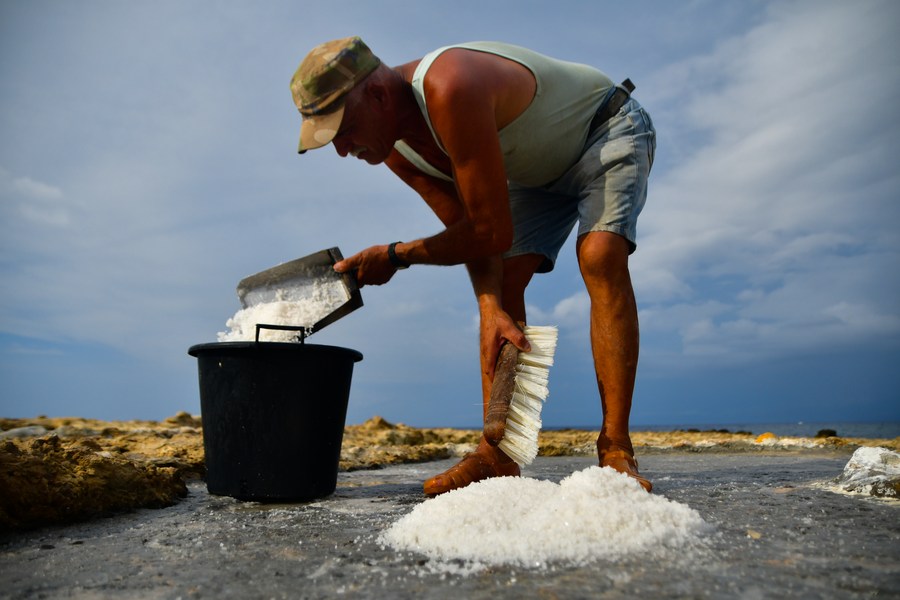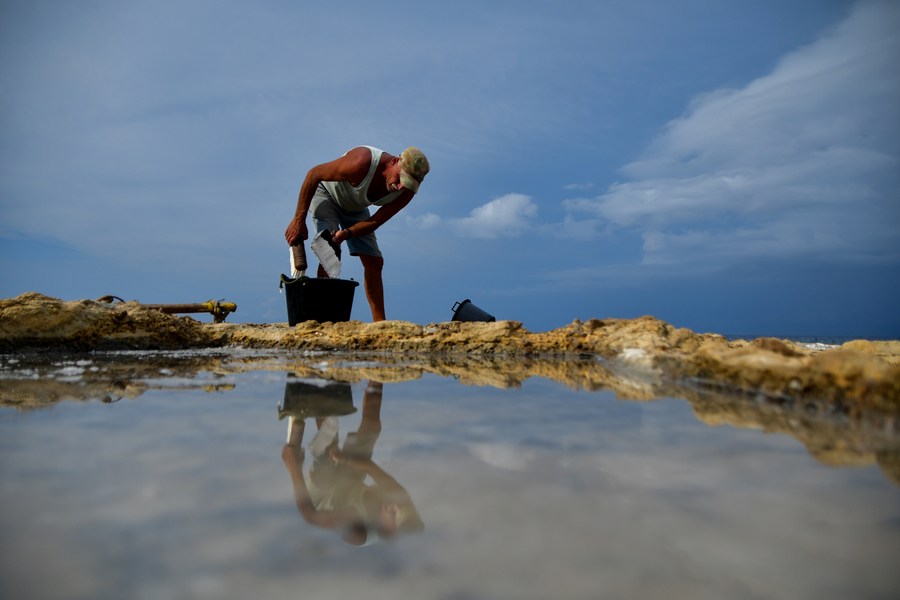
Alfred Attard, who has been harvesting sea salt for almost five decades, collects sea salt from rock-cut salt pans at a village in Gozo, Malta, on Sept. 7, 2020. Surrounded entirely by the sea, Malta is a large producer of sea salt through rock-cut salt pans. (Photo by Jonathan Borg/Xinhua)
Unfortunately, sea salt containing natural iodine, magnesium and calcium is no longer popular, with many opting for the less healthy option of mined table salt. Attard proudly says that nothing beats his salt and that when sprinkled on food, it can bring any meal up to a whole new level.
"There's nothing better than mine. Mine is simply the best," Attard exclaims as he bursts out singing the famous Tina Turner song.
VALLETTA, Sept. 27 (Xinhua) -- Alfred Attard was still young when he started assisting his father-in-law in the collection of sea salt from salt pans. They worked together at the seaside village of Xwejni in Gozo, an island that forms part of the archipelago of Malta.
Forty-five years later and with his father-in-law already gone, he still bears the same passion for the traditional craft, saying he could not see himself doing it any other way.
Tanned and weather-beaten, Attard is now one of the few remaining sea salt harvesters in Malta.

Aerial photo taken on Sept. 7, 2020 shows rock-cut salt pans at a village in Gozo, Malta. Surrounded entirely by the sea, Malta is a large producer of sea salt through rock-cut salt pans. (Photo by Jonathan Borg/Xinhua)
According to him, they have resisted technological advancements and still harvest sea salt as past generations did. Attard's family has been harvesting salt for two centuries and the profession is passed on from generation to generation.
He produces around 100 tonnes of sea salt every season, but this very much depends on the season and the weather conditions.
"No season is like the previous ones. There's a big element of luck here but you also need to know what you're doing," he told Xinhua in an interview at his salt pans at Xwejni Bay.
Attard explained that the salt harvesting season runs between April and October until the first storms fill up the salt pans with rainwater instead of seawater.

Alfred Attard, who has been harvesting sea salt for almost five decades, carries buckets of salt at a village in Gozo, Malta, on Sept. 7, 2020. Surrounded entirely by the sea, Malta is a large producer of sea salt through rock-cut salt pans. (Photo by Jonathan Borg/Xinhua)
He said that the laborious process behind the salt that people use as seasoning on their food takes around 14 days from start to finish.
When the salt pans are ready, the seawater is drained and the remaining substance is left there to evaporate for about a week. Two kilograms of salt per pan are left behind, with the meticulous process requiring a tricky balance of moisture and dryness that only the trained eye can identify.
Attard often begins at six in the morning and continues late into the evening, sweeping salt out of the pans and preparing for its collection.
The sea salt is moved around at regular intervals. In the summer, it's left in the heat to dry out until the collection process two weeks later.

Alfred Attard, who has been harvesting sea salt for almost five decades, carries buckets of salt at a village in Gozo, Malta, on Sept. 7, 2020. Surrounded entirely by the sea, Malta is a large producer of sea salt through rock-cut salt pans. (Photo by Jonathan Borg/Xinhua)
Aided by other members of his family, the sea salt is carried into small rooms and cut into rocks for the continuation of the process.
He packs it into small sacks and the salt is sold as artisan sea salt. He sells big buckets for seven euros (8.20 U.S. dollars), two-kilogram bags for five euros, medium bags for two euros and the small bags for one euro.
Unfortunately, sea salt containing natural iodine, magnesium and calcium is no longer popular, with many opting for the less healthy option of mined table salt. Attard proudly says that nothing beats his salt and that when sprinkled on food, it can bring any meal up to a whole new level.
"There's nothing better than mine. Mine is simply the best," Attard exclaims as he bursts out singing the famous Tina Turner song.

Alfred Attard, who has been harvesting sea salt for almost five decades, collects sea salt from rock-cut salt pans at a village in Gozo, Malta, on Sept. 7, 2020. Surrounded entirely by the sea, Malta is a large producer of sea salt through rock-cut salt pans. (Photo by Jonathan Borg/Xinhua)
Attard admits that his job is a physically strenuous one, but vows to continue collecting sea salt for as long as he has the strength to do so.
Joseph Borg, a medical doctor at the state-run Mater Dei Hospital, agreed with Attard. He told Xinhua that processed table salt sold in supermarkets is worse for health than natural sea salt.
"Sometimes bad salt can ruin your dish and it can also ruin your health. Salt in small doses is good for your health but the purer the salt the better," said Borg.
"Pure sea salt, like the one you buy almost directly from the salt pans, is the best you can go for," he said.

Alfred Attard, who has been harvesting sea salt for almost five decades, collects sea salt from rock-cut salt pans at a village in Gozo, Malta, on Sept. 7, 2020. Surrounded entirely by the sea, Malta is a large producer of sea salt through rock-cut salt pans. (Photo by Jonathan Borg/Xinhua)■



